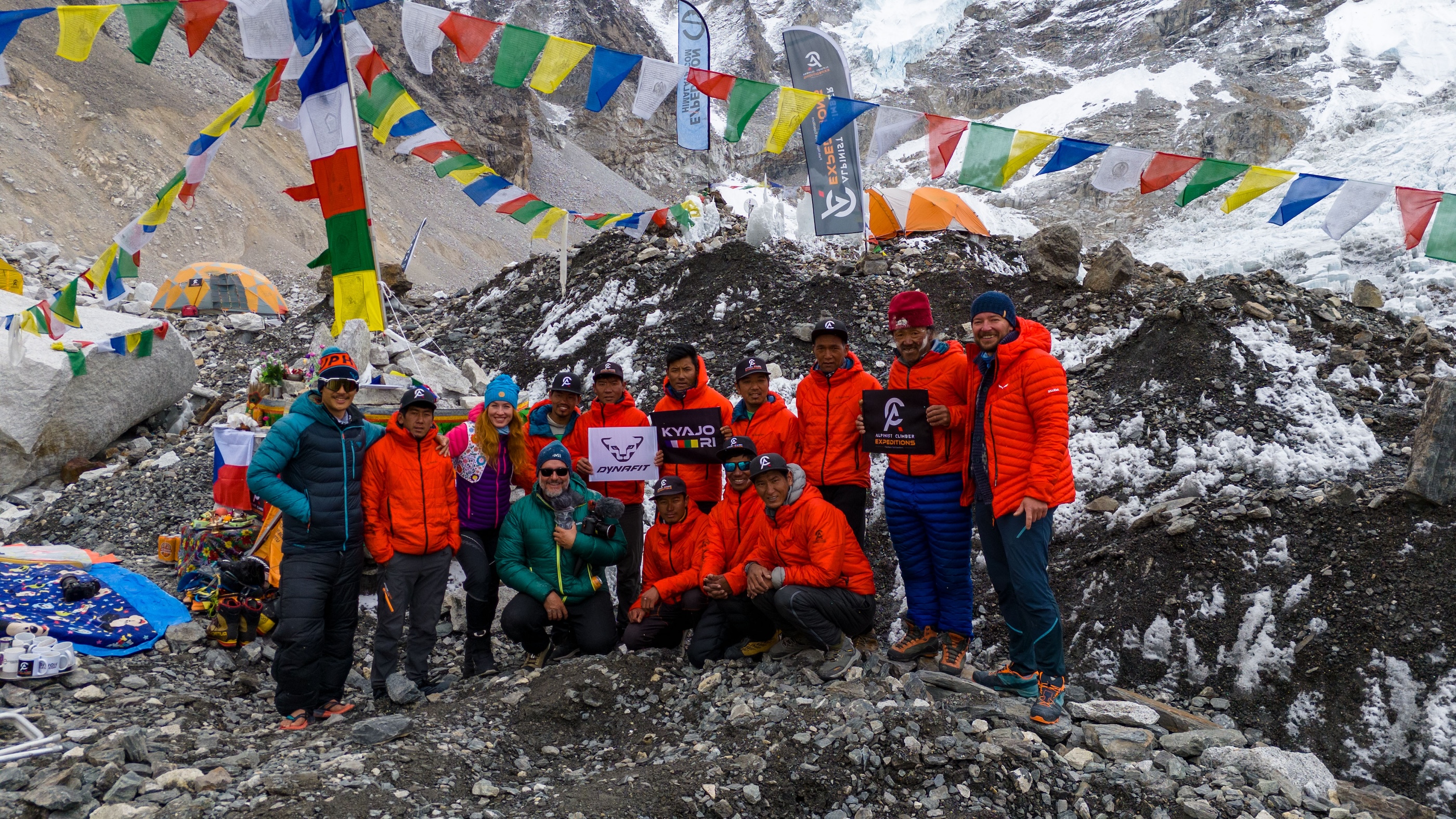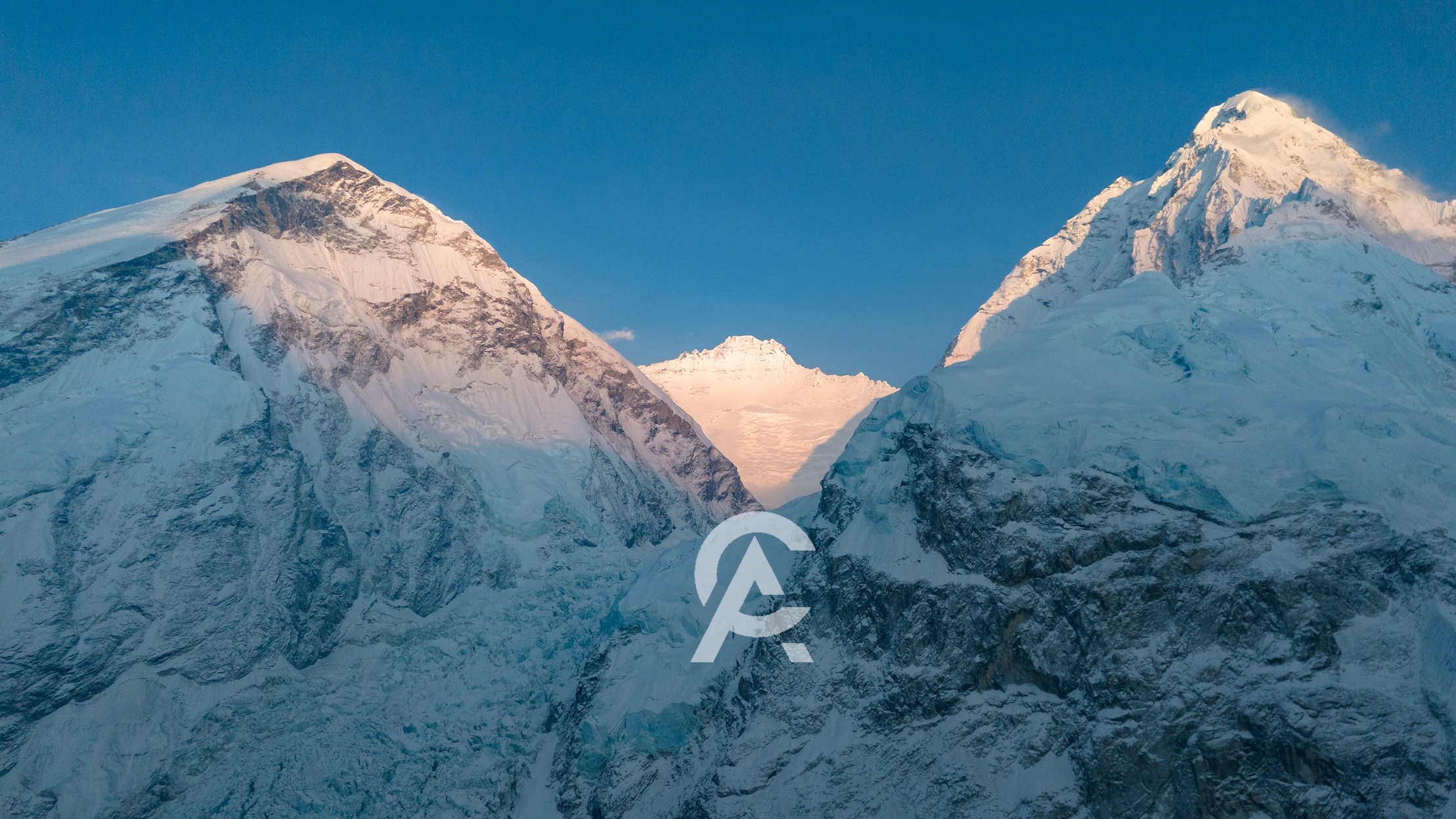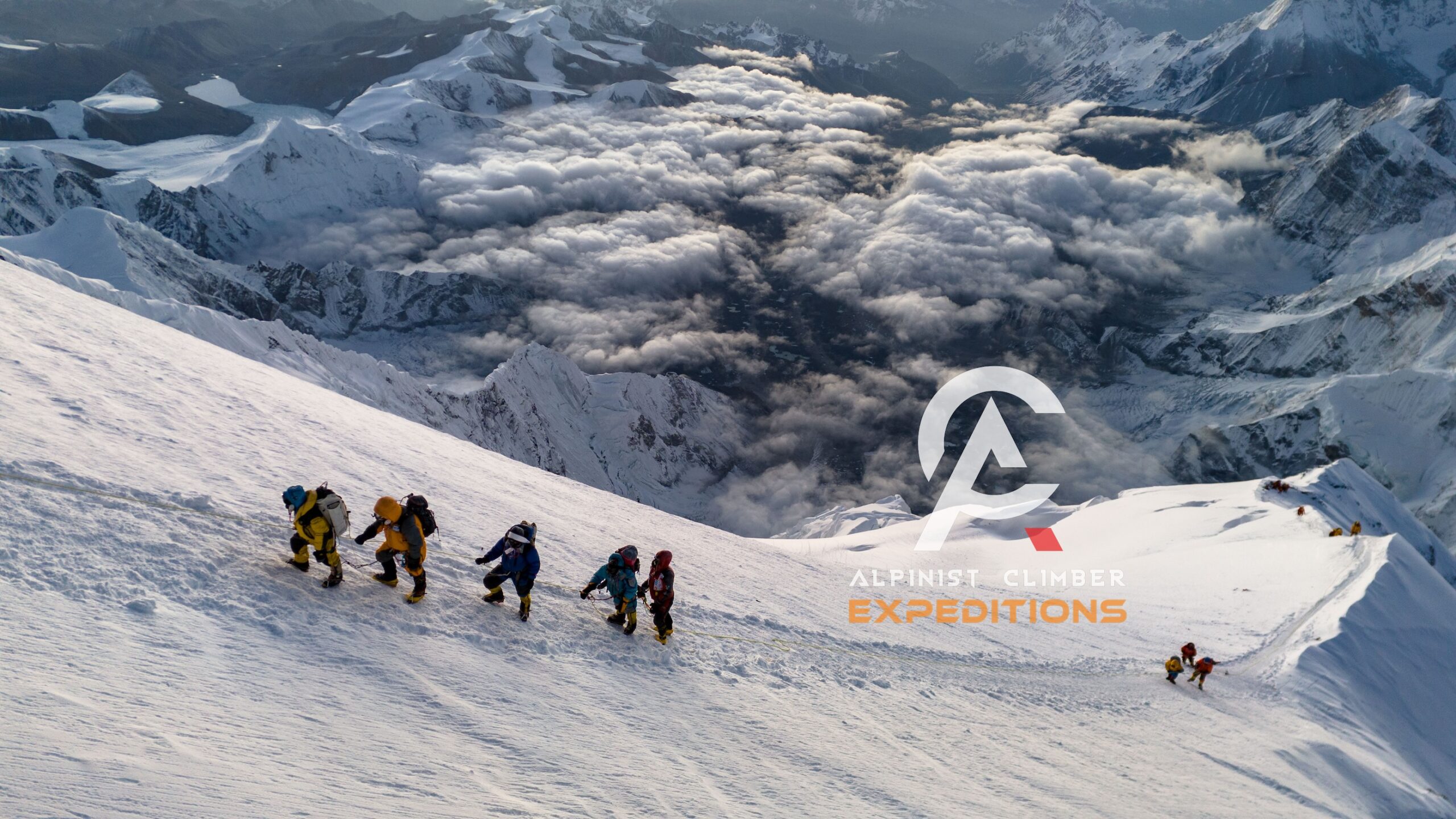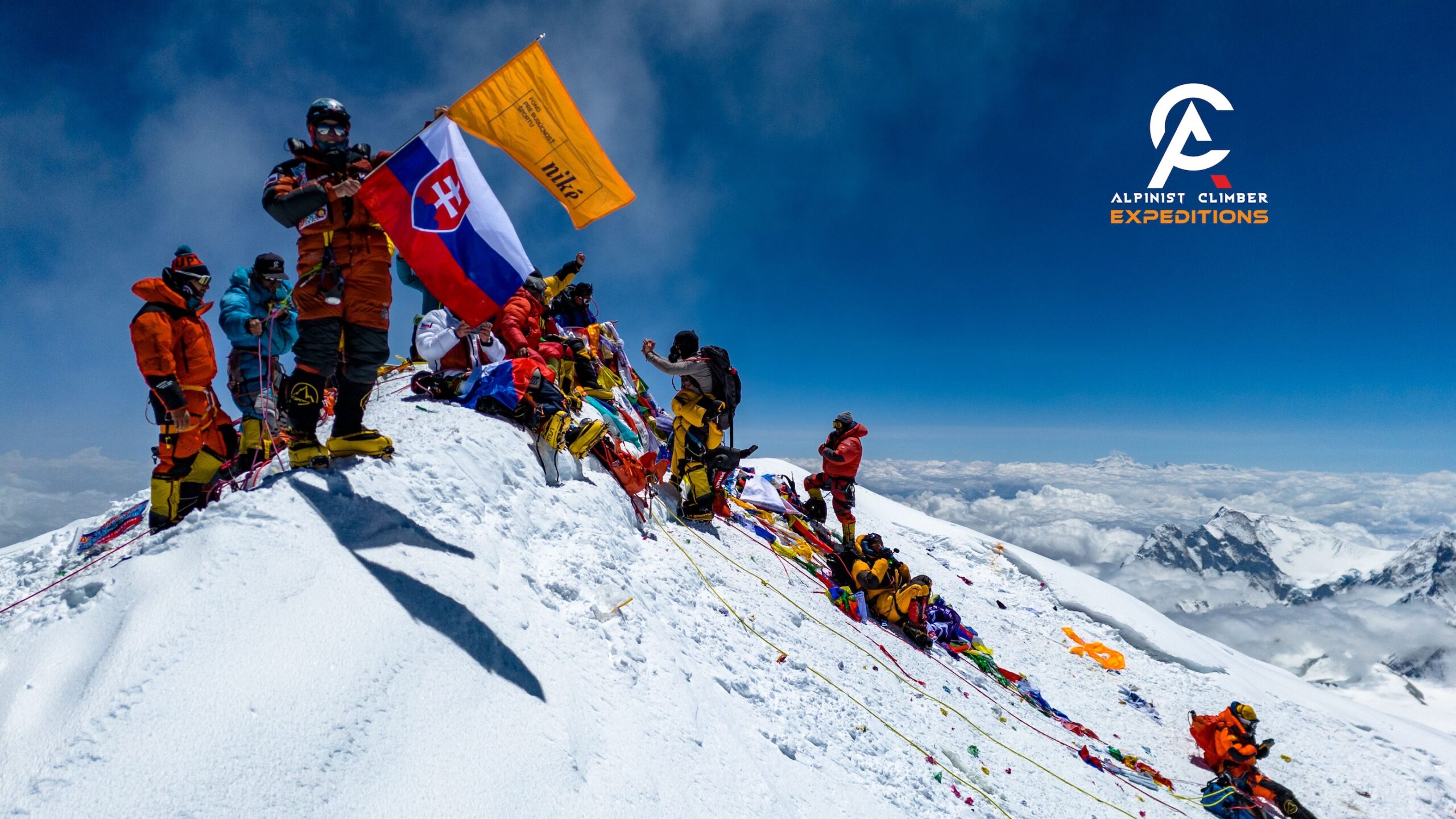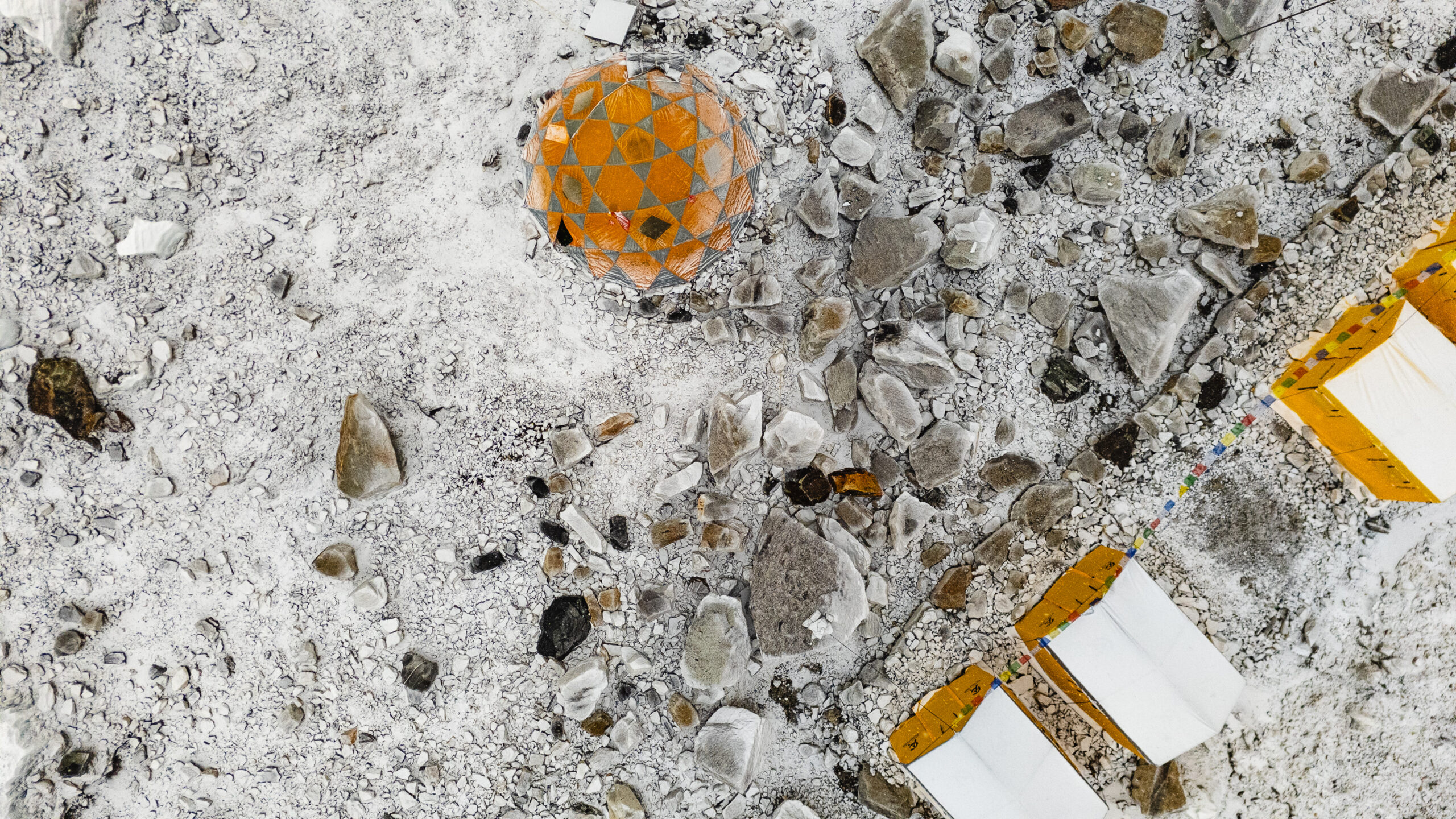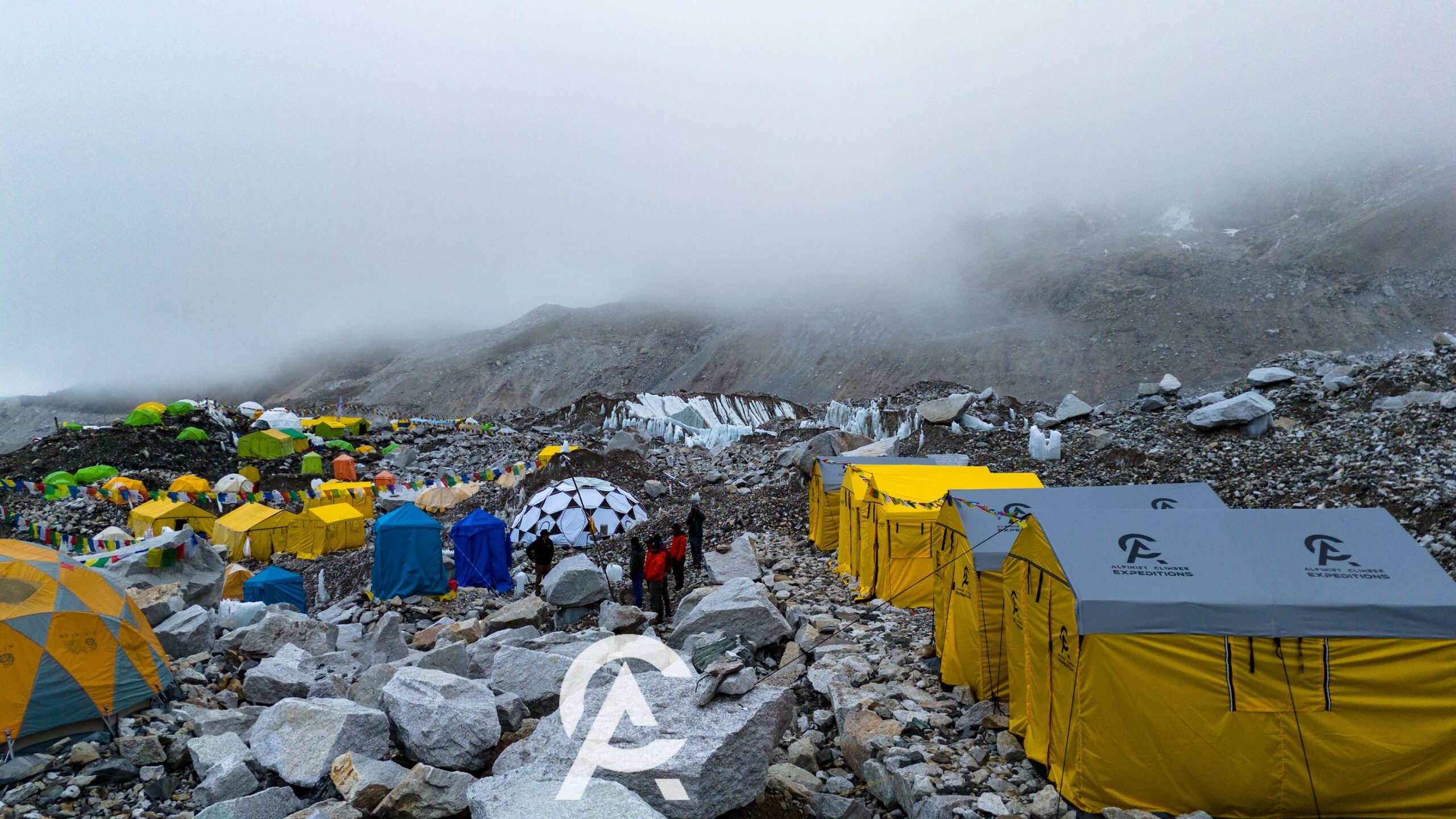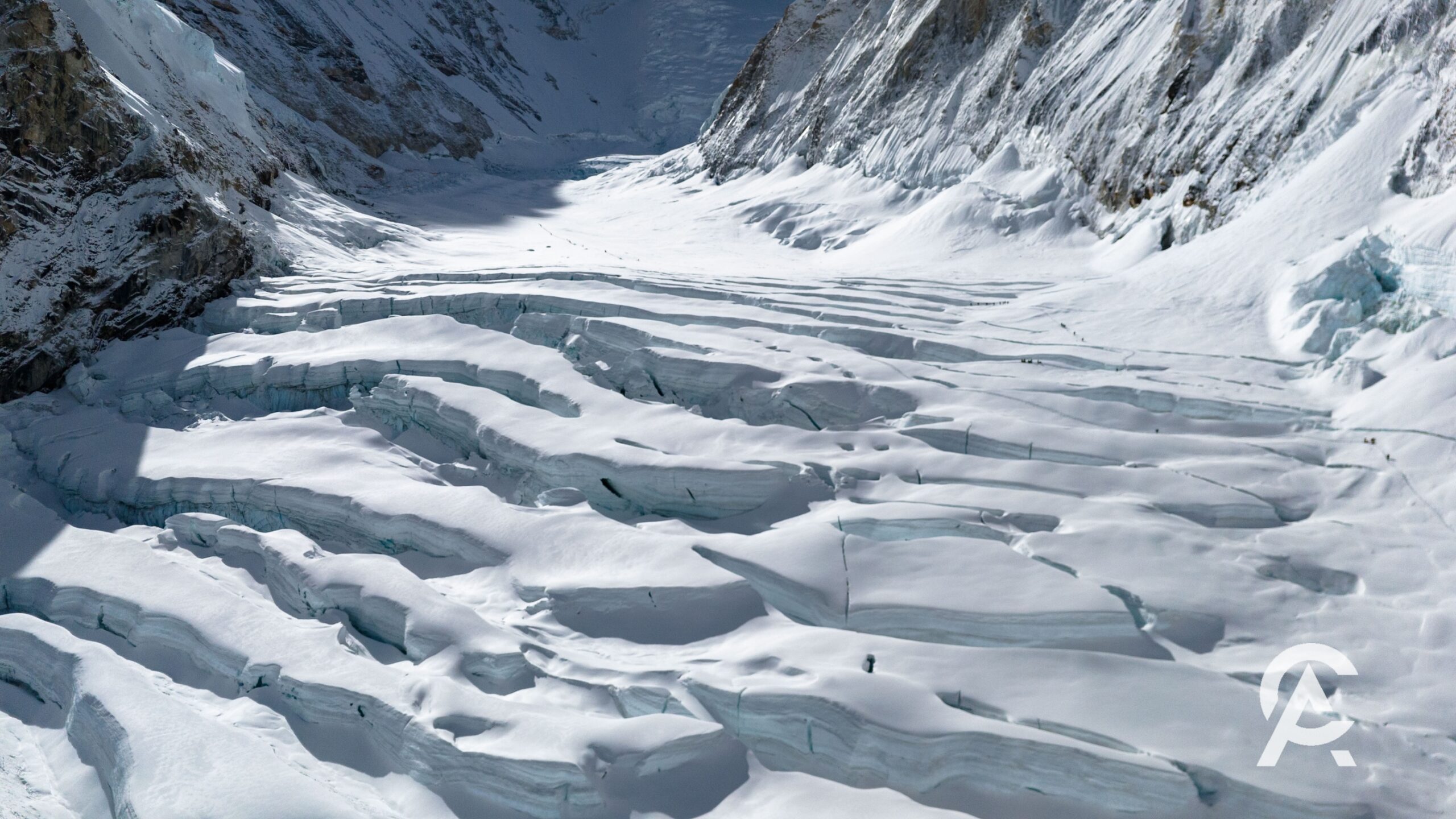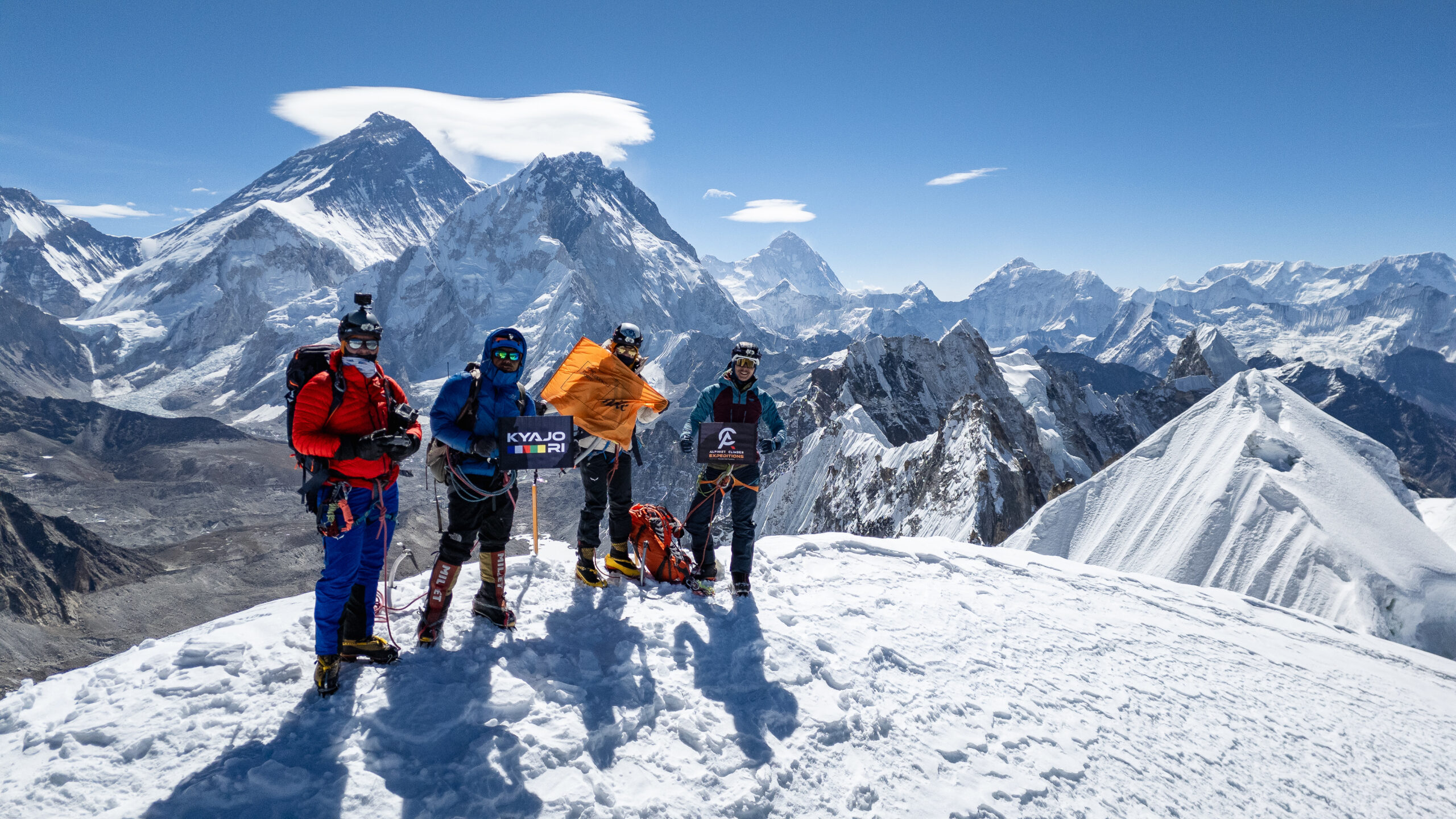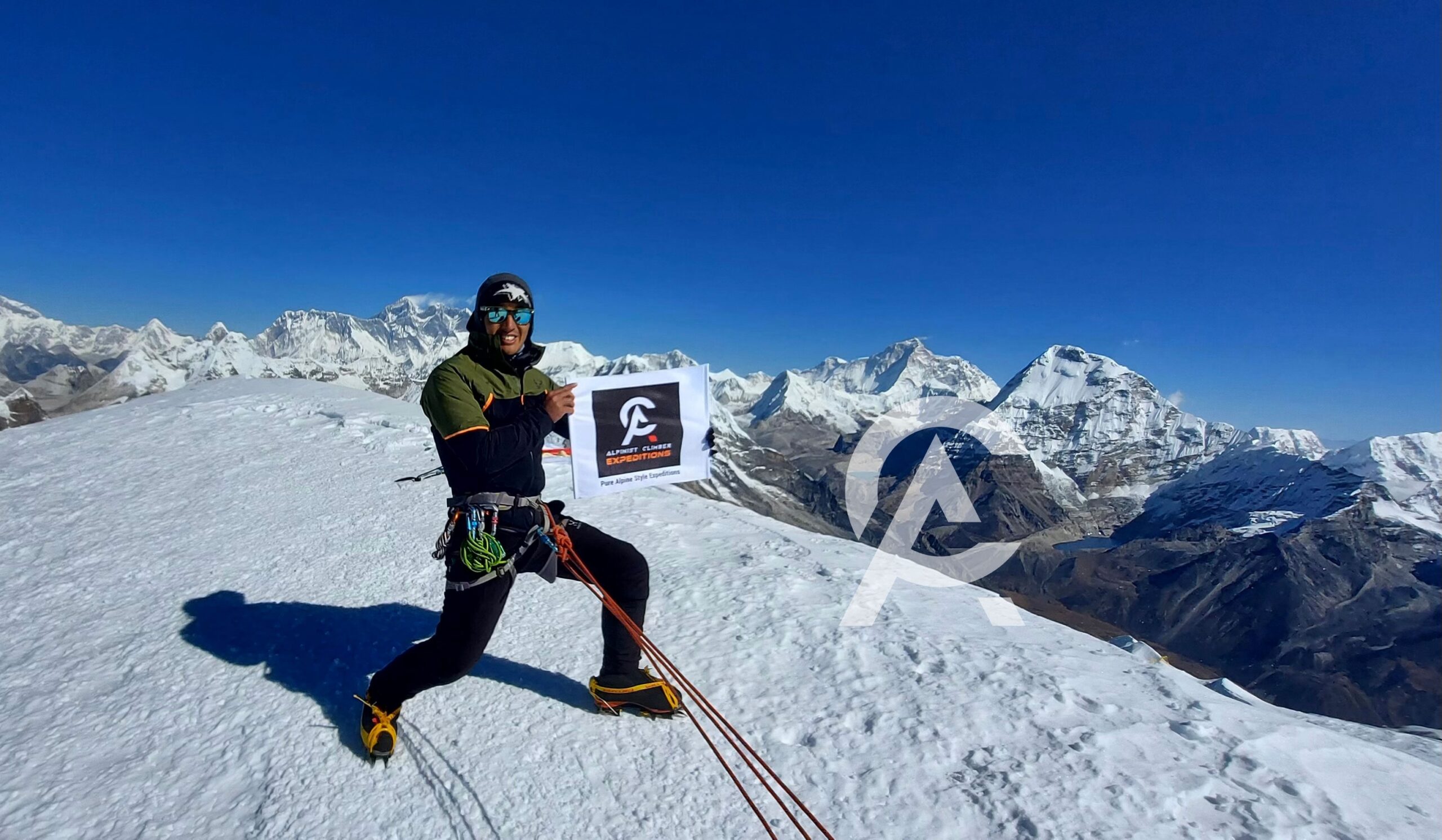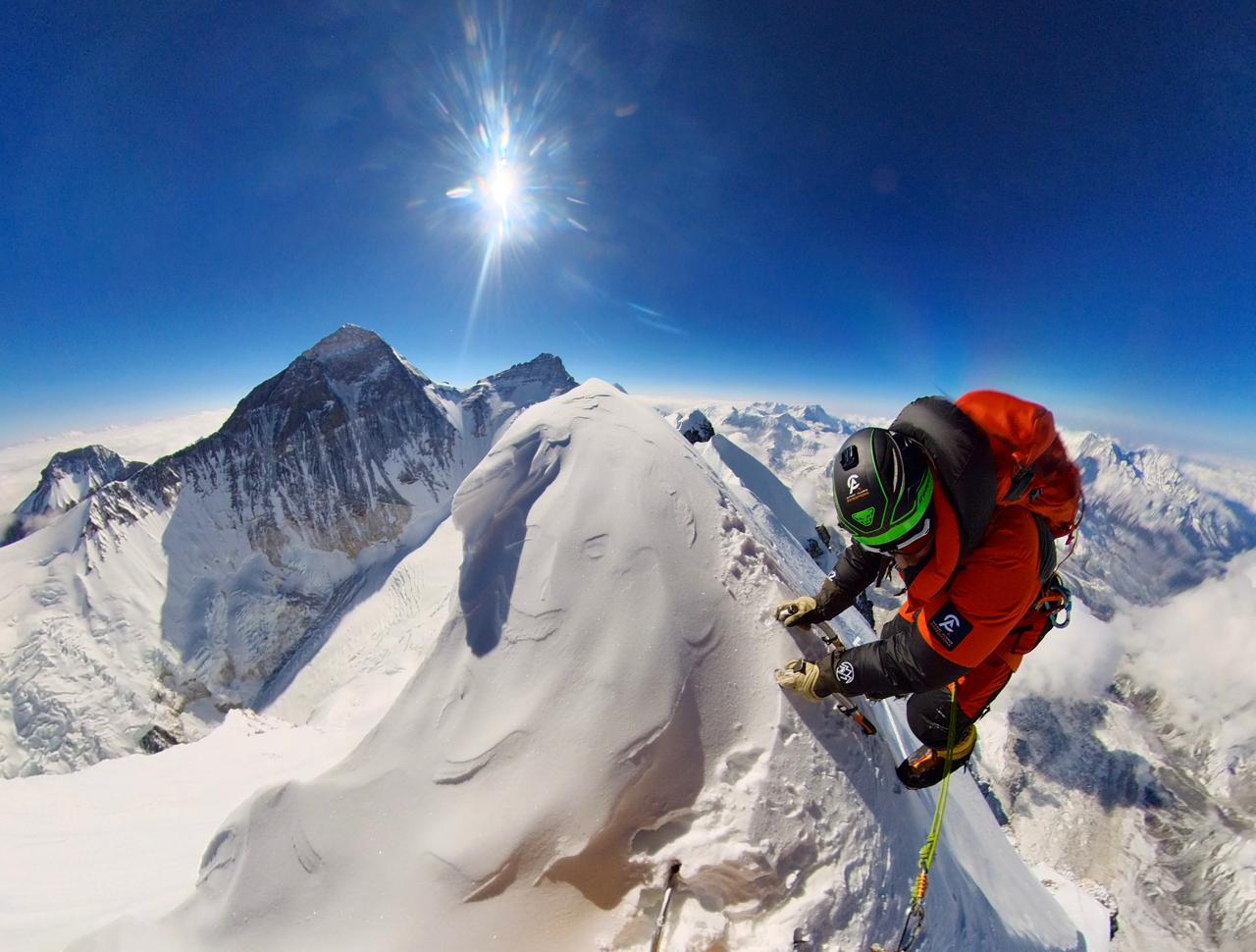Everest Expedition 2025
Mount Everest, known as the highest mountain on Earth, stands at a staggering height of 8,848.86 meters (29,031.7 feet) above sea level. It is located in the Himalayas, on the border between Nepal and the Tibet Autonomous Region of China. The mountain is part of the Himalayan mountain range, which is home to some of the world’s most famous peaks.
The Alpinist Climber Expedition’s strategies and approach to climb Mount Everest have been the reasons that helped us to keep up with the highest success rates. We give a high Guide ratio, ensuring the right support for your summit and the safety.
As the climbers stand on the summit, they also become part of an exceptional adventure. However, it is crucial to remember that the mountain demands respect. As well as safety should always be the first priority for those who dare to attempt the climb.
Difficulty Level
Hard
Best Season
Spring
Duration
58 days
Elevation
8,848.86m
Group Size
2 - 6
Trip Type
8000M Expedition
2025
8000M Expedition
- Starts from Kathmandu, Nepal
Overview
Mount Everest, known as the highest mountain on Earth, stands at a staggering height of 8,848.86 meters (29,031.7 feet) above sea level. It is located in the Himalayas, on the border between Nepal and the Tibet Autonomous Region of China. The mountain is part of the Himalayan mountain range, which is home to some of the world’s most famous peaks.
Geography and Location:
- Latitude/Longitude: 27°59′17″N, 86°55′31″E
- Everest’s summit marks the point where the borders of Nepal and China (Tibet) meet.
Name:
- The local name for Mount Everest is Sagarmatha in Nepali and Chomolungma in Tibetan. Sagarmatha translates to “Forehead in the Sky,” while Chomolungma means “Goddess Mother of the World.”
- The mountain is named after Sir George Everest, a British surveyor-general of India in the 19th century.
First Successful Ascent:
- The first successful ascent of Mount Everest was made on May 29, 1953, by Sir Edmund Hillary of New Zealand and Tenzing Norgay, a Sherpa of Nepal.
- Their historic climb is one of the most famous achievements in mountaineering history.
We continuously develop and upgrade our overall operations to ensure your involvement with the best expedition available. We know our expedition members do not deserve anything but the best! Keeping in mind in giving you the optimum opportunity to summit, we reduce our team size in order for the group to the summit on the best weather day; usually, there are only a few available summit days! Big groups offering cheap climbs often miss out as they split their groups resulting in missing the best potential summit days.
Our guides are experienced professionals who are trained and qualified through the International Federation of Mountain Guides Associations (IFMGA) equipped with a superior repertoire of skills that enables them to provide a remarkable level of security to you throughout the expedition. The guide’s expertise is predominantly around making decisions to keep you safe and healthy and to avoid mishaps throughout the expedition.
This relies on years of first-hand experience on the expeditions. For a decade we have been providing the most current communications systems for our expeditions. These deliver comprehensive weather forecasts which help us to plan our ascent around favorable weather.
An attempt at Mount Everest is undoubtedly a serious commitment and undertaking. It requires a huge amount of dedication and a strong determination to be successful. Serious enthusiasts and ready to be successful on an ascent of the world’s highest mountain, and you want a platform that allows you the perfect chance of getting that goal in a fun-relaxed team atmosphere or private expedition, then the Alpinist Climber Expeditions is your perfect choice.
This is our usual itinerary. It can be slightly changed if required considering your pace and trekking and Climbing habits that may cause a change of day-to-day plan.
Itinerary
Day
Arriving in Kathmandu
When you arrive at Kathmandu airport our representative from Alpinist Climber Expeditions will be there to greet you and when you have gone through customs formalities our representative will pick you up and transfer you to your hotel. Once you are checked in our mountain guide and other participants will go through the final preparation for the trip. In the evening get ready to be introduced to Nepali cuisines.
Trip briefing and preparation
As the leader goes through formal procedures through the Ministry of Tourism you will be engaged in exploring the fascinating sights of the city. Our guided tour will lead you to some UNESCO World Heritage Sites in the Kathmandu valley. This final day is also for final necessary arrangements and a last-minute briefing on the expedition and grouping with the expedition team.
Fly to Lukla and trek to Phakding
This Fresh early morning takes us on a scenic flight to Lukla. This mountain flight to Lukla is filled with beautiful and dramatic landscapes and is considered to be a beautiful air route that you can fly over. In Lukla our guides and porters and other crew members will go through packing arrangements then we will finally embark on our journey through a colourful and prosperous village of Lukla to Phakding which serves us well serviced clean lodges where we can call it a day.
Trek to Namche Bazaar
We will be trekking from Phakding Village to Namche Bazaar. We will continue up the banks of the Dudh Koshi, crossing it twice by small suspension bridges before reaching the village of Monjo where we will enter in the check-point of Sagarmatha National Park. We will then cross the confluence of the Dudh Koshi and the Bhote Koshi on a high suspension bridge and hike steeply for about three hours up ‘Namche Hill’ to reach Namche Bazaar.
Rest and acclimatisation day
We acclimatize and rest allowing our body to rejuvenate at an altitude of 3,440m. Namche Bazaar is the perfect place for an extra night and acclimatization, as we need to adjust to the low oxygen levels. So, we will hike up to Everest view point and explore the area around Khumjung. We will come back here to spend the night.
Trek to Tengboche
We begin our journey to the famous monastery of the Everest Region, Tengboche Monastery. The initial part of the trek is uphill and becomes gentler before it descends to a gentle mountain stream. It goes steep uphill towards Tengboche after crossing the stream. Tengboche is a small and beautiful village that has great views of mountain peaks. The monastery is popularly known as Tengboche Monastery and is a rich example of Buddhist cultural traditions found in the region. We unfold many monasteries before spending overnight here.
Trek to Pheriche
Pheriche is a village located in the Khumbu region of eastern Nepal. Situated at an altitude of 4,371m. We take on a high traverse that passes through the village of Pangboche (3,985m), a pleasant village with great views. We will stop at Pangboche to rest and eat lunch and after lunch we will visit an old Buddhist monastery to take blessings to continue our hike. Therefore, it’s common to see Himalayan Tahr and Danphe, the Himalayan pheasant on the trail.
Rest and acclimatisation
One more day in Pheriche for acclimatisation. During the acclimatisation day, we can hike to the top of the Nangkartshang peak altitude of 5,083 m. It takes approx 2-3 hrs walk to reach the top of Nangkartshang peak, from this peak we are able to see beautiful mountains view and back to Pheriche.
Trek to Lobuche
After breakfast at 7 am, we will pack our bags and move towards Lobuche. The trail is well established but it has its rocky sides with short uphill sections. On the way, we have lunch and stop for tea. We then pass an interesting monument in memory of those who have lost their lives on the mountain. It’s really something you should see! We will sleep at the lodge tonight.
Trek to Gorak Shep
It will take 3/4 hours to reach Gorak shep from Lobuche. The climb is challenging as one can strongly feel the effects of high altitude and one may experience altitude sickness. After crossing moraine Gorak Shep (5160m) is reached at the foot of Kala Pathar.
Trek to Everest base camp
On this, we trek to Everest Base Camp! We will wake up early to start our trek to Base camp, which takes approximately 2 hours. We cross glacial moraine on mixed rocky terrain with a lot of up and downhills. While walking on the glacier you will be gaining elevation until base camp.
Years of experience have helped us to establish the finest Base Camp (5,364 m) on the mountain with the highest quality tent structures, including private sleeping tents. Our dinning tent is carpeted and heated with Wi-Fi and a movie screen is available.
We provide hot showers at your request. We strive to ensure that the time at Base Camp is restful and revitalizing. By providing these accommodations, we make every effort to keep climbers healthy and rested.
Rest and Puja Ceremony day
We partake in the Puja is a traditional ceremony commenced by a Lama where the Mountain Gods are asked permission for the climbers to climb, forgiveness for the damage caused by the climbing, and safety for all who are involved. All the team members, Sherpa climbers, cooks – anyone associated with the climb is invited to participate or observe.
General Climbing Schedule
When you reach the mountain, your schedule is always subject to change. Delays are common, along with early departures.
Before we reach the base camp our guides will be well ahead in the lower part of the mountain (the Khumbu Icefall) fixed with ropes and ladders. Altogether four camps will be established in the mountain. The first one is camp I (5,943 m), situated at the top of the icefall. The camps are based until camp II. Camp II is established at 6,400 m in the Western Cwm. It consists of large tents for cooking and dining and also for sleeping until the placements of camp III (7,300m) and camp IV (7,900m) sequentially.
Camp III established at the top of the cirque on the Lhotse Face will have three –and four-man tents. This mid-way camp assists us to reach Camp IV ( Last Camp ) on the South Col. Our Sherpas carry directly from camp II to Camp IV therefore large amounts of gear are not necessary at camp II to proceed to camp IV. Oxygen is applied above camp II to assist climbers to reach camp IV before attempting the summit. From Camp IV we’ll head on to the Southeast Ridge to the South Summit. From there on we’ll keep on traversing for a few hundred meters before reaching the main summit leaving behind The Hillary step (8,790m).
Summit attempts: When all of our supplies are in a good place and in order and after establishing the camps of III and IV, we retreat to Base camp (and lower villages) for a rest. From the Base camp, we will prepare for the attempts at the summit. When we are ready we will return to camp 2 and given good weather we’ll guide the summit team to camp III. Day second, the team will move onto camp IV, and on the third day will be the day of the summit. We will start very early in the morning and attempt to reach the summit of mount Everest before midday. After the summit of Everest, we will retreat back to the South Col and the next day we will descend to camp 2. Our guides and Sherpa climbers will accompany all the summit attempts and we all climbers team will use the supplementary oxygen.
Packing and cleaning base camp
Before we leave base camp, we all join hands to show our appreciation and clean up the base camp and descend to Lobuche.
Trek to Lobuche
We descend to Lobuche Village from the Everest base camp. Lobuche is the small settlement on the way that leads us to Pangboche.
The elevation of Lobuche Village is 4940m. This locality remains busy for almost throughout the year and thousands of Sherpas and porters cross through this region on their way to base camp.
Trek to Pangboche
After having breakfast, From Lobuche we head back to Pangbuche, it is located high in the Himalaya in the Imja Khola valley. Today, we trek down through the hillside, take downhill while returning on the Everest high trail that gathers whole new impressions. Before arriving at the Sherpa village of Pangboche (3,985m) we cross a small Pheriche pass, (4,270m) along the foaming banks of Imja Khola.
Trek to Namche Bazaar
We move forward through a downhill trail to Namche. You walk the same route to reach Namche Bazaar so it will be more like a revision of the scenery around but heavenly views of peaks like Everest, Nuptse, Lhotse, etc.
After few hours of hiking on the uphill and downhill trails, you’ll be back in Namche Bazaar. Otherwise, you can explore more sights in Namche if anything had passed you by earlier. And also, there are plenty of shops where you can pick up souvenirs for family or friends.
Trek to Lukla
We head back to Lukla from Namche Bazaar as the trail descends through the luscious pine trees. Following Dudh Koshi River and crossing the suspension bridges a few times until reaching Phakding village from here onwards the walk is pleasant and gentle all the way to Lukla.
Fly to Kathmandu
We catch an early flight to Kathmandu after our long mountain journey. we can rest or go souvenir shopping or explore other areas of Kathmandu, we may do that today. There will be a farewell celebration dinner in the evening to celebrate the successful completion of our journey.
Final departure
This day is to fly back home or to join destinations that you may have and also to take away the beautiful memories of the expedition and as we all bid farewell, we hope to see you again and hope for a safe journey back.
Inclusions & Exclusions
The price of your trip includes the following:
- Everest climbing royalty fees
- Certified IFMGA mountain guide with his daily wages and full insurance etc
- Garbage disposal & management fees
- Government liaison officer with his wages, Insurance, transportation, etc
- Sagarmatha national park permit and Tims entry fees
- Summit route fixing and SPCC fees
- Hotel / Airport pick up and drop by private tourist vehicle
- 4-star hotel in Kathmandu with breakfast for 4 nights
- Flight from Kathmandu to Lukla both way
- Base Camp single Dome tent per person and hot shower
- Alpinist Climber Expeditions duffle bag, Cap, and T-shirt per member
- Accommodation & food in the local lodge are on full board during the trip
- Medical kit during the trip
- Porters to carry trekking and expeditions gear (1:1 ratios)
- Camp 1, camp 2, camp 3, and south col tents for members and guides
- Unlimited oxygen and Mask regulator for member and guide
- High food for members and guides
- Experienced Sherpa support with his wages, full insurance
- All our government taxes, vat, tourist service charges
- Satellite Phone for emergency case
- Special drone permit fees
- All accommodation, wages, insurance, equipment, and medicine for all staff
- All official expenses
- Climbing Sherpa 1:1 ration to carry personal equipment and summit day
The price of your trip does not include:
- International flight tickets
- Nepal entry visa fees
- Meals in Kathmandu
- Alcoholic beverages
- Internet wifi
- Personal clothing and climbing equipment
- Climbing sherpa summit bonus
- Personal travel insurance, medical and rescue insurance
- Tips for Staff Guide, Sherpa, and Porters
Cost Details
Details
Our budget cost option presents an affordable alternative for individuals seeking a mountaineering experience without the higher price tag of the regular and premium options. This package retains the same level of service as the regular option, including group guiding with a minimum of 4 people per group, offering the chance to share the journey with fellow adventurers. The budget cost package encompasses professional guidance from our skilled team, a well-structured itinerary, and accommodations in budget hotels and lodges throughout the trip.
Details
Our regular cost option offers an excellent value for adventurers seeking an unforgettable mountaineering experience. With this package, you’ll have the opportunity to attempt stunning peaks, receive professional guidance from our experienced team, and enjoy a well-planned itinerary. Designed for groups, the regular cost option requires a minimum of 2 members to join the expedition, ensuring a shared experience and camaraderie throughout the journey. It’s an affordable and exciting way to embark on a memorable mountaineering adventure.
Details
- Private 1:1 guiding service for each member
- More flexibility
- Travel consciously
- Enjoy exclusive benefits
For those seeking a truly personalised and flexible adventure, our premium cost option is the perfect choice. With the premium package, you’ll receive exclusive benefits such as 1:1 private guiding, allowing for a more personalised experience tailored to your specific goals and preferences. This option provides the utmost flexibility in scheduling and ensures that you receive dedicated attention from our expert guides throughout the expedition. Indulge in the luxury of private guiding and elevate your mountaineering experience with our premium cost option.
Payment Details
Account Information
- Bank Name: Nepal Investment Bank Ltd
- Account Holder Name: Alpinist Climber Expeditions Pvt. Ltd.
- Account No: 00101010343367
- Account Type: US Dollars
- Swift Code: NIBLNPKT
- Branch: Durbar Marg Kathmandu 44600
- Email. [email protected]
- Phone No: +977-9851364253
Why ACE ?
Alpinist Climber Expeditions is known for its expertise in leading pure alpine style expeditions, and 1:1 private guiding with a certified IFMGA mountain guide. Having more than a decade of years of experience in the planning and coordination of mountaineering expeditions, we achieve in ensuring each expedition is a successful one with the best possible experience for our climbers while focusing on our 3 primary goals which are, reaching the summit, returning safely, and having fun! Safety is always our number one priority.
Our IFMGA mountain guides are the best and most experienced in the guiding field. you’ll find having a strong grasp of technical climbing, expedition, and high-altitude experiences, along with strong interpersonal skills. Our teams offer the best support system available that ensures the highest chance of success.
Trip Notes
The team will have a minimum size of 4 members and 2 IFMGA guides and a maximum size of 6 members and 3 IFMGA guides. The base camp will be staffed by a Sherpa sirdar/cook. A team of climbing Sherpas will carry loads above base camp and support in the mountain.
1. Pre-Expedition Preparation
a. Physical Preparation
- Conditioning: Train for months prior to your expedition. Focus on cardiovascular fitness (running, cycling, swimming), strength training (leg strength and core), and endurance. High-altitude training (e.g., at altitude gyms or using a hypoxic tent) is highly beneficial.
- Climbing Experience: Ensure you have experience with high-altitude climbs, particularly above 6,000 meters (20,000 feet). Previous climbs of peaks like Ama Dablam, Aconcagua, Manaslu or Denali are common prerequisites for attempting Everest.
- Mental Resilience: Psychological preparation is key. The conditions on Everest can be harsh, and there are long periods of isolation and mental strain. Mental toughness can be the difference between success and failure.
b. Base Camp and Acclimatization
- Trekking to Base Camp: Climbers typically start their journey by trekking from Lukla (the nearest airport to the Everest region) to Everest Base Camp (EBC), which takes about 8-12 days, depending on the pace. This trek passes through iconic locations like Namche Bazaar, Tengboche, and Pheriche.
- Acclimatization: Nirekha (6,159m) peak or Lobuche East (6,119m), climbers will spend several days to acclimatize to the high altitude. This is critical to prevent altitude sickness.
- Acclimatization Strategy: Climbers ascend to higher camps and then return to Base Camp for rest (the “climb high, sleep low” method). This process may take 2-3 weeks.
c. Climbing the Mountain
- Camp I (6,065 meters / 19,900 feet): The first camp is located on the Khumbu Icefall, a challenging section with crevasses and seracs (ice pillars). Climbers must navigate this perilous terrain carefully. The icefall is usually the most dangerous part of the ascent.
- Camp II (6,400 meters / 21,000 feet): This is located on the Western Cwm, a high-altitude plateau. The Cwm is relatively flat, but climbers still face the risk of avalanches. It’s typically used as the first stop on the way to higher camps.
- Camp III (7,200 meters / 23,600 feet): Camp III is positioned at the base of the Lhotse Face, a steep section of the mountain. The terrain here is more technical, requiring climbers to use fixed ropes and crampons.
- Camp IV (7,900 meters / 25,919 feet): Located at the South Col, this is the final camp before summiting. Climbers typically rest here for a night before making their final push to the summit.
- Summit Push (8,848 meters / 29,031 feet): The final ascent to the summit from Camp IV takes 6-12 hours, depending on conditions. The route is exposed, and climbers use supplemental oxygen to cope with the thin air. Reaching the summit is a remarkable achievement but also a moment for extreme caution. Climbers must return to lower camps quickly to avoid the dangers of staying in the “death zone” too long.
2. Key Considerations for Success
a. Weather
- Conditions on Everest are extreme. Temperatures can drop below -60°C (-76°F) with wind chill. Weather forecasts are crucial for planning summit attempts. The best time to summit is generally in May, during the post-monsoon window, when the weather is more stable.
- Weather Forecasts: Mountaineers rely on weather forecasts from both meteorological stations and experienced guides to determine the best time for a summit attempt.
b. Oxygen
- Supplemental Oxygen: At altitudes above 8,000 meters, the air contains only about a third of the oxygen available at sea level. Supplemental oxygen is essential for most climbers. You will need to carefully manage your oxygen supply and ensure you are familiar with how to use the oxygen system.
c. Teamwork and Sherpas
- Sherpas play a vital role in the expedition. They often serve as guides, carrying heavy loads, setting up camps, and fixing ropes in dangerous sections like the Khumbu Icefall and the Lhotse Face.
- Having strong communication, respect for each other, and mutual support within your team and with your Sherpas is key to success.
3. Summit Day: The Final Push
- Timing: The summit attempt is typically made in the early hours of the morning to avoid the dangerous afternoon storms and the extreme cold. Climbers usually aim to reach the summit before noon.
- Summit Window: The summit window is narrow due to Everest’s severe weather conditions. Climbers must be flexible and ready to make decisions based on the forecast.
- Return: After reaching the summit, climbers must descend immediately to avoid staying in the death zone too long. Many climbers face exhaustion, frostbite, or other challenges during the descent.
- Celebration and Reflection: Summiting Everest is a huge achievement, but for many, the real victory is in surviving the journey and sharing the experience with the climbing community.
4. Risks and Challenges
- Altitude Sickness: Symptoms include headaches, nausea, dizziness, and loss of appetite. Severe cases can lead to High Altitude Pulmonary Edema (HAPE) or High Altitude Cerebral Edema (HACE), which are life-threatening and require immediate descent.
- Frostbite: Due to extremely low temperatures, frostbite is a significant risk. Proper clothing and regular checks of extremities are essential.
- Traffic on the Mountain: During peak seasons, Everest can be crowded, leading to delays and dangerous Hillary Step or South summit, particularly near the summit.
Prakash Sherpa (Pemba) CEO / IFMGA Mountain Guide
The expedition is being organized by Prakash Sherpa, director of Alpinist Climber Expeditions and a veteran of decades of High altitude expedition guiding and organizing. All of our trip guides have extensive experience at high altitudes and a proven record of safety, success, and compatibility. The number of guides is determined by the team size but the normal ratio of guides to members is 1.2 You will find our guides companionable and strong expedition members with considerable power and willingness to see you achieve your goals.
Climbing Guide – Sona Chhiri Sherpa
Nationality: Nepalese. Gender: Male
Training qualification: Advance Mountaineering Course, Basic Mountaineering Course, High Mountain Rescue Course, Basic rescue course, Ice Climbing Course, Trekking Guide Course.
Sona Sherpa has successfully climbed multiple peaks over 8000-meters. 5 times Everest 8848m. Lhotse 8516m. Barunste 7,162m, Putha hiunchuli 7246m, Ama Dablam 6,812m, Mera Peak 6,476m, Island Peak 6,189m, Lobuche East 6,119m.
Equipment
Bodywear
- Down suit – Recommended the best brand
- Down jacket – recommended the best brand
- Waterproof jacket and over-trousers that goes over your alpine boot
- Balaclava – recommended BUFF or similar covering nose and face
- Long sleeve thermal shirt and trousers
- Fleece jacket and trousers
Handwear
- Liner gloves – thin and warm
- Down mitts
- Gore-Tex Primaloft glove.
- Mountain gloves – recommended water and windproof
- Smartwool mountaineering socks (2 pairs – new)
- Ultra-soft running / Hiking socks (2 pairs – new)
- Mountaineering boot – recommended La Sportive, etc.
- Alpine boot – recommended La Sportive and Scarpa, etc.
Climbing Equipment
- Climbing Helmet (UIAA tested)
- Harness – recommended Petzl or BD
- Goggles with UV protection and anti-fog system
- Sun glasses UV protection
- Headlamp – recommended Petzl or BD
- Spare batteries – recommended Energizer Ultimate Lithium batteries
- Ascender (Jumer) – recommended Petzl or BD
- Abseiling device – recommended Petzl or BD ATC guide
- Screw gate carabiners (2 x large, 2 small sizes) recommended Petzl or BD
- Bent gate carabiners (2 medium sizes) – recommended Petzl or BD
- 6 mm rope – recommended 2 meters UIAA tested
- 6 mm rope – recommended 5 meters UIAA tested
- Dynamic 8 mm rope – recommended 2 meters UIAA tested
- Classical alpine ice-ax – recommended Petzl, Grivel, or BD
- Crampons that fit mountaineering boots – recommended Grivel, Petzl, or BD
Other equipment
- Sleeping bag (comfort rated – 20 degrees
- Large size duffle bag with padlock
- Headlamp with spare batteries
- Water bottles 1 liter
- First aid kit
- Trekking poles
- 45–75-liter Rucksack
- Swiss army knife with a multi-tools system or Leatherman
- 1-liter stainless steel thermos – that works in extreme weather conditions
Headwear
- Sun hat or Normal Cap
- Fleece or woolen hat
- Sunglasses with UV protection
- Buff scarf / thin face mask
Handwear
- Fleece or woolen thin gloves
- Gore-Tex mitten gloves
Bodywear
- Gore-Tex jacket
- Gore-Tex pant
- Hiking pant
- Fleece trousers and jacket or warm jumper – recommended not thick but warm enough that fits inside the Gore-Tex pant
- Anti-sweat T-shirt
- Thermal inner trouser
- Down jacket with hoodie
Footwear
- Trekking boots
- Slipper
- Trekking socks (4-5 pairs)
- Snow gaiter
- Alpine Boots
- Crampons
- Climbing equipment
Other equipment
- Sleeping bag (comfort rated – 20 degrees
- 45-liter rucksack with cover
- Large size duffle bag with padlock
- Headlamp with spare batteries
- Water bottles 1 liter
- Thermos
- First aid kit
- Trekking poles
Washing kit & Toiletries
- Waterproof washing kit bag
- Towel – medium size
- Washing soap, towel, tooth pest, toothbrush, etc.
- Sun lotion enough +50SPF (including total bloc for lips, nose, etc.)
- Handwash & sanitizer
- Toilet paper (you can buy it in the Lodges)
- Wet tissues
Terms & Conditions
Please read our terms and conditions carefully. Terms and Conditions are an essential part of the trip for members who wish to book an Expedition, Peak climbing, or trekking trip with Alpinist Climber Expeditions.
The terms and conditions inform the client about the booking confirmation, payment and refund system, cancellation policy, and other important information about your trip. The Booking Terms and Conditions form a legally binding agreement between Alpinist Climber Expeditions and you for the services to be provided. The specific details of our Terms and Conditions can be found below.
- Alpinist Climber Expeditions accepts Euros (€) and US dollars (US$) as payment. The currency will be applied based on the client’s location. After the initial deposit/payment, all subsequent fees will be charged in the same currency.
- When Alpinist Climber Expeditions issues the written confirmation receipt of your deposit amount the
existence of the booking will be confirmed. Alpinist Climber Expeditions kindly requests you to make a
deposit of 20% cost of your trip. You are supposed to pay the remaining amount upon your arrival in
Kathmandu. You need to send your deposit to the Company. In the case of the customized trip, you
should do a 50% deposit as it will cover all intensive details. We accept a last-minute booking with 100%
payment in some cases.
- If you wish to make amendments to your tour arrangements we require notification to Alpinist Climber
Expeditions in writing. If any government permits, flight tickets, or insurance has been issued and cannot be
revoked and refunded you will be liable for these costs. You may also be liable for the cancellation fee of airfares purchased on your behalf.
The future is unpredictable. Notice of cancellation shall be submitted by the client in writing providing
a reason(s) for cancellation. The refund procedure will be as follows:
- Cancellation before 60 days of the trip, 20% cancellation will be charged.
- Cancellation Before 30 days of the trip 40% cancellation will be charged.
- Cancellation Before 15 days of the trip 60% cancellation will be charged.
- Cancellation Before 07 days of the trip 70% cancellation will be charged.
If cancellation is made within the week of the departure or upon arrival in Kathmandu no
refund shall be provided. Any remaining payment will be required at this time. The cost of
Climbing Permit/Insurance/Equipment allowance is not refundable in any period of cancellation.
- Travel insurance is not included in the tour price, but it is a required condition of booking a trip with
Alpinist Climber Expeditions and your responsibility to ensure that you are adequately insured for the
full duration of the trip covering expenses against all possible risks including missed flights, canceled
trips, baggage loss, emergency medical evacuation, high altitude accidents, and other unforeseeable
events. All costs for emergency evacuation must be paid in cash in Nepal unless an insurance
company has agreed to pay the costs on your behalf. It is important to ensure that your personal
travel insurance covers all of the activities you participate in the Himalayas.
- The client / You are responsible to insure yourself with an insurance policy that covers
medical expenses, flight cancellation, trip cancellation, emergency evacuation, and any other
unforeseeable events that may cause loss to you.
- The client is responsible to bear all expenses of personal nature and any extra cost resulted
due to extended stay because of natural calamities, political strikes, and any uncontrollable
events.
- The client is responsible to book the flight tickets with a flexible time frame as traveling in the
The Himalayas can be unpredictable. In case of missed flights, the client shall be solely
responsible to bear the loss.
- If you wish to add extra services mentioned by the company in the Cost Inclusions
section of each package, you shall be entitled to bear the extra costs.
- The company is fully responsible to provide all the services mentioned in the Cost Inclusions
section.
- The company is responsible to introduce all the team members to guides, Climbing
Sherpas, Staff, and manager.
- The company is fully responsible to make the best arrangements for food, lodging, and
accommodation during the trip.
- The company is responsible to hear out the concerns of the member in terms of safety.
- The company is responsible to make prompt arrangements in case of emergencies during the
trek and expeditions.
- The company is responsible to provide valuable service to the clients and deserves pay to
the staff.
- It is your responsibility that you carry a valid passport and have rightly obtained the appropriate
visas when traveling with Alpinist Climber Expeditions. Please ensure that your passport is valid for 6 months from the Nepal Visa validity date.
- As part of the booking and permit process, we will need to obtain personal information from each
client. Your personal will be kept by us in a secure way and none of your private or personal
information will be disclosed for any other purpose.
- This agreement and the rights and obligations of the parties will be construed and take effect in
accordance with and be governed by the laws of Nepal.
Wishing you the best time in Nepal, Come as a friend goes as a family….. The land of Adventure and Hospitality.
FAQs
Everest Expedition is a hard climb so that means that a previous experience in a 6000m or 7000m peak is necessary to feel comfortable during the climb. Physical conditioning is also crucial, involving cardiovascular endurance, strength training, and acclimatization exercises. Prior experience with high-altitude climbs and technical ascents is highly recommended to ensure safety and success on the challenging terrain of Everest. During the expedition you will be able to learn with our guides the basic mountaineering techniques.
Everest expedition trip, we provide 1:1 private guiding lead IFMGA Mountain Guide and team of Sherpa guide will assist the loads during the climb and summit day.
For the upcoming Everest expedition trip our director and IFMGA mountain guide Prakash Sherpa will be leading the expeditions. Prakash Sherpa has summited Everest 4 times, and several other 8000m successful summit. Among with him, other experienced guides will assist you during the climb. We want to ensure that our clients will have a safe and successful trip with us.
Prakash Sherpa and Sona Chhiri Sherpa were guiding Lenka Polarckova on Everest in May 2024. The expedition was organised by Alpinist Climber Expeditions.
Lenka Polarckova was the world’s 10th woman who climbed Everest without oxygen.



